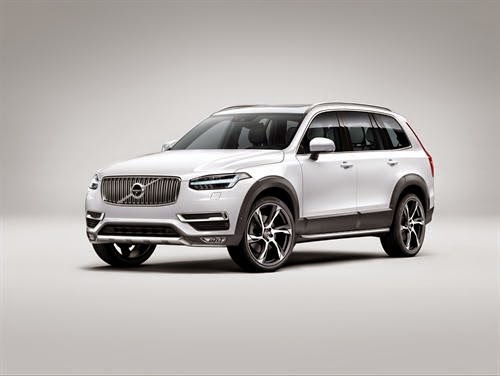Economic news: Volvo withdraws from global motor shows
In a shock marketing money-saving tactic, Volvo Sales and Marketing Vice President Alain Visser has revealed that Volvo will not be involved with any motor shows but Detroit, Geneva and Beijing.
Above: Scenes such as this will be few and far between for Volvo, as it opts out of all but three major motor shows.
Choosing instead to focus upon online marketing and social media, Volvo's withdrawal from all motor shows but the three most prominent in their main markets (USA, Europe and China) is an attempt to trim Volvo's marketing expenditure and focus upon the return gained from it. Volvo is also focusing upon a Volvo-only product day, like a miniature motor show, but exclusively by Volvo.
When asked the reason for withdrawing from some of the most notable and popular motoring events on the calendar, Visser suggested that less mainstream marketing techniques may be more effective. After the roaring trade done with the opening of the new XC90's order books, Visser may be on to something, and judging by Volvo's recent decisions, it is very much playing to its strengths in a period of persistent uncertainty.
Above: could this be the future of Volvo's product launches, as it withdraws from all but three major motor shows?
As a company which prides itself on reliability and design, the idea of presenting its own products to the world isn't quite so far removed from the practices of electronics giant, Apple. Being a brand firmly based in self-promotion rather than mass fanfare and trade shows, Apple has garnered huge success and popularity, in part thanks to its now iconic keynote presentations on its products, popularised by Steve Jobs. To say that Volvo is thinking along these lines may be a stretch, however it's not so farfetched to suggest that the same inspiration may have sparked inside the marketing structure of Volvo.
Image credit: Aljawad, Wikimedia.
7/1/15
Economic news: Volvo announces most successful year in two decades
It's official: Geely's takeover of Volvo and its subsequent growth plans for the once ailing Swedish manufacturer are finally being realised. An increase of 26% year-on-year in the UK, along with 18 consecutive months of growing sales spells the end of a troubling time for Volvo. Global sales increased by 8.9%.
The V40 and its variants proved to be the best-selling cars in the UK for Volvo, in spite of criticisms of its dynamics and handling. Volvo's foray into the Chinese market thanks to its parent company, Geely, meant that its best-selling car globally was the XC60. The launch of the new XC90 also means that the transition into the new year continues this wave of success. Volvo's growth plans to expand back into markets it was once familiar with are also looking more positive at this news, and their success means that this growth is likely to be exponential.
After Geely's €11billion injection into Volvo, economists were unsure of whether the previously fragile Volvo could pull through its near-fatal encounter with Ford's Premier Automotive Group, however, with numerous safety innovations and publicity, as well as the launch of two new segment-busting engines as well as a model with a fearsome reputation even before its debut, it could easily be argued that Volvo is very much on a roll.
Economic news: Volvo announces most successful year in two decades
It's official: Geely's takeover of Volvo and its subsequent growth plans for the once ailing Swedish manufacturer are finally being realised. An increase of 26% year-on-year in the UK, along with 18 consecutive months of growing sales spells the end of a troubling time for Volvo. Global sales increased by 8.9%.
Above: the XC60 proved popular in China, and went on to become Volvo's bestselling car of the year.
The V40 and its variants proved to be the best-selling cars in the UK for Volvo, in spite of criticisms of its dynamics and handling. Volvo's foray into the Chinese market thanks to its parent company, Geely, meant that its best-selling car globally was the XC60. The launch of the new XC90 also means that the transition into the new year continues this wave of success. Volvo's growth plans to expand back into markets it was once familiar with are also looking more positive at this news, and their success means that this growth is likely to be exponential.
Above: The V40 was the UK's most popular Volvo, helping it achieve a 26% year-on-year increase in sales.
After Geely's €11billion injection into Volvo, economists were unsure of whether the previously fragile Volvo could pull through its near-fatal encounter with Ford's Premier Automotive Group, however, with numerous safety innovations and publicity, as well as the launch of two new segment-busting engines as well as a model with a fearsome reputation even before its debut, it could easily be argued that Volvo is very much on a roll.
Above: The new XC90 is expected to continue Volvo's good fortunes into 2015.
On Volvo's appeal over competitors, Media Relations Manager Martin Bayntun stated "Choosing a Volvo is a statement of quiet confidence – our customers don’t want to follow the crowd or shout about status/wealth, but they do demand a credible, premium experience. A modern Volvo caters to that demand with high quality and driver pleasure together with family friendly safety, design and technology built in."
http://www.newspress.co.uk/ViewPressRelease.aspx?pr=55253
Interview material: original content obtained via email interview with M. Bayntun
Interview material: original content obtained via email interview with M. Bayntun


















